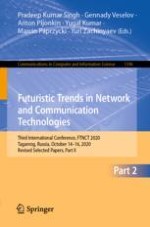2021 | Buch
Futuristic Trends in Network and Communication Technologies
Third International Conference, FTNCT 2020, Taganrog, Russia, October 14–16, 2020, Revised Selected Papers, Part II
herausgegeben von: Dr. Pradeep Kumar Singh, Gennady Veselov, Anton Pljonkin, Prof. Yugal Kumar, Marcin Paprzycki, Yuri Zachinyaev
Verlag: Springer Singapore
Buchreihe : Communications in Computer and Information Science
